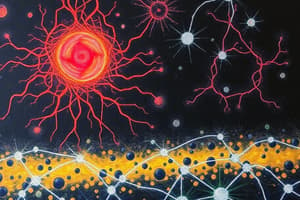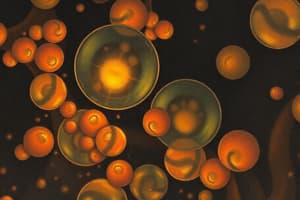Podcast
Questions and Answers
What is the defining structural and functional unit of an organism?
What is the defining structural and functional unit of an organism?
The cell is the basic structural and functional unit of an organism.
What are the main components of the plasma membrane?
What are the main components of the plasma membrane?
The plasma membrane is primarily composed of phospholipids, proteins, and cholesterol.
What does the term lipidome refer to in the context of cell membranes?
What does the term lipidome refer to in the context of cell membranes?
Lipidome refers to the entire lipid composition of the cells of an organism.
What are lipid rafts and their significance in the plasma membrane?
What are lipid rafts and their significance in the plasma membrane?
Describe the structural characteristics of caveolae in the plasma membrane.
Describe the structural characteristics of caveolae in the plasma membrane.
What distinguishes single-pass transmembrane proteins from multi-pass transmembrane proteins?
What distinguishes single-pass transmembrane proteins from multi-pass transmembrane proteins?
Explain the role of peripheral membrane proteins in signal transduction.
Explain the role of peripheral membrane proteins in signal transduction.
Identify two functions of membrane proteins and give an example for each.
Identify two functions of membrane proteins and give an example for each.
What is the glycocalyx and what is its significance in the plasma membrane?
What is the glycocalyx and what is its significance in the plasma membrane?
How do anionic oligosaccharides contribute to the properties of the glycocalyx?
How do anionic oligosaccharides contribute to the properties of the glycocalyx?
Flashcards
Cell Definition
Cell Definition
The cell is the basic building block of an organism, performing all essential life functions.
Plasma Membrane Structure
Plasma Membrane Structure
The plasma membrane is the cell boundary, made of phospholipids, proteins, and cholesterol.
Membrane Lipids
Membrane Lipids
Membrane lipids are the foundational parts of cell membranes, consisting mainly of phospholipids.
Lipid Rafts
Lipid Rafts
Signup and view all the flashcards
Caveolae
Caveolae
Signup and view all the flashcards
Integral membrane proteins
Integral membrane proteins
Signup and view all the flashcards
Peripheral membrane proteins
Peripheral membrane proteins
Signup and view all the flashcards
Membrane protein functions
Membrane protein functions
Signup and view all the flashcards
Glycocalyx
Glycocalyx
Signup and view all the flashcards
Membrane proteins & signaling
Membrane proteins & signaling
Signup and view all the flashcards
Study Notes
Cell Physiology Outline
- The cell is the basic structural and functional unit of an organism. It contains the fundamental constituents of life.
- Cells are made up of a plasma membrane and cytoplasm.
- The plasma membrane is a physico-biological membrane separating the cell's interior from its external environment. It's composed of phospholipids, proteins, cholesterol, and carbohydrates.
- The plasma membrane has a fluid mosaic structure.
Plasma Membrane Components
- Lipids: Phospholipids are most abundant; each has a hydrophilic head and hydrophobic tails. Examples include phosphatidylcholine, phosphatidylserine. Lipid rafts are small, dynamic, sterol- and sphingolipid-rich domains that compartmentalize cellular processes. Caveolae are flask-shaped or cup-shaped invaginations of the membrane.
- Proteins: Integral proteins span the membrane, acting as transporters, receptors, and enzymes. Peripheral proteins are associated with one leaflet of the phospholipid bilayer.
Membrane Functions
- Cell attachment and support.
- Cellular signaling (lipid rafts form scaffolds for signaling molecules and receptors that relay information).
- Regulation of cellular homeostasis (lipid rafts regulate lateral diffusion of proteins in response to stimuli).
- Vesicle budding and fusion (important in exocytosis/endocytosis coupling).
- Membrane remodeling is carried out by caveolae.
- Cellular/membrane transport.
Intracellular Components
- Cytoplasm: A gelatinous solution, containing cytoskeleton and 75-95% water, carbohydrates, fats, and proteins.
- Cytosol: The liquid portion of the cytoplasm.
- Organelles: Specialized structures with characteristic shapes and specific functions.
Endoplasmic Reticulum (ER)
- A dynamic membrane-bound organelle that extends from the nuclear envelope.
- Synthesizes, transports, and controls quality of components in the cell.
- Made of flattened sacs and branching tubules.
- Rough ER has ribosomes on its surface, involved in protein synthesis.
- Smooth ER lacks ribosomes, involved in lipid metabolism.
- Transitional ER is also part of the ER, involved in transporting secretory proteins to the Golgi complex.
Golgi Complex
- A central station for protein modification, sorting, and secretion (or degradation via the lysosomal pathway).
- Comprised of membrane-bound compartments (cisternae) stacked like a plate.
- Vesicles transport molecules between the ER and Golgi complex, and from the Golgi to destinations in the cell.
- Proteins and lipids are modified sequentially inside the cisternae, and molecular labels/tags are added by resident enzymes.
- The Golgi sends the final products to various parts of the cell via trans face vesicles. Some proteins might be targeted to lysosomes.
Peroxisomes
- Roughly spherical, single membrane-bound organelles that mediate various biosynthetic and biodegradative reactions.
- They produce key components of the cell.
- They contain enzymes required for the synthesis of ether phospholipids, bile acids, and docosahexaenoic acid (DHA).
Lysosomes
- Acidic and dynamic organelles that degrade extracellular and intracellular particles.
- Cleave materials to produce amino acids, monosaccharides, free fatty acids and nucleotides.
- Helps recycle components from worn-out cells.
- Maintains an acidic pH (~5.0) within the organelle.
- Defective lysosomal enzymes cause storage diseases. Leakage causes cellular autodigestion (autolysis).
Mitochondria
- Complex oblong organelles found in all eukaryotic cells.
- They are the "powerhouses" of the cell, converting oxygen and nutrients into energy.
- The major site of ATP synthesis in aerobic cells.
- Possess their own DNA (mtDNA) and machinery.
- Contain the enzymes of the citric acid cycle and electron transport chain.
- Possess intra-organelle spaces (matrix and intermembrane space).
Nucleus
- Highly specialized and dynamic membrane-bound organelle.
- Houses genetic material (DNA and RNA).
- Contains the nucleolus, a region involved in ribosome synthesis.
- The nuclear membrane regulates the exchange of materials between the cytoplasm and nucleoplasm.
- Contains chromosomes (DNA-protein complex) in a non-dividing cell, and chromatin in dividing cells.
- Important for intermediary metabolism, protein synthesis, and RNA synthesis.
Ribosomes
- Small granular organelles that are part of the macromolecular machinery for translating genetic code into functional proteins.
- Two types exist in mammalian cells: cytoribosomes and mitoribosomes.
- Cytoribosomes are found on the rough ER; mitoribosomes are found in the mitochondria.
- Composed of large and small subunits.
Centrosomes
- Dense area of cytoplasm, near the nucleus, a membrane-less organelle consisting of a pair of centrioles.
- Surrounded by pericentriolar material.
- Centrosome is the microtubule organizing center of the cell, involved in cell division and other functions.
Cytoskeleton
- Dynamic network of filamentous polymers (intermediate filaments, microtubules, microfilaments, septs) and regulatory proteins.
- Located throughout the cytosol.
- Involved in maintaining cell shape, structural support, cellular transport, cell movement, cell division, and other processes.
Vesicles
- Small membrane- enclosed transport units used to transfer molecules between different cellular compartments.
- Include clathrin-coated and coat protein complex-I-coated vesicles.
- Often involved in transport to and from the Golgi complex.
Models of Plasma Membrane
- Bilipid Layer Model: Phospholipids form a bilayer; heads face outward, tails inward.
- Fluid Mosaic Model: Proteins embedded within the lipid bilayer; membrane is fluid, and components move freely.
- Dynamic Fluid-Mosaic Model: Nonrandom distribution of membrane proteins and lipids that form clusters; emphasizes fluidity and mosaicism aspects simultaneously.
Studying That Suits You
Use AI to generate personalized quizzes and flashcards to suit your learning preferences.



